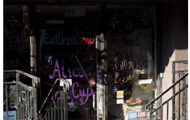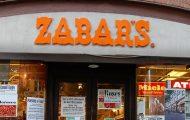On certain nights in the mid-1970s, flutist Michael Parloff could be heard playing for diners at Ruskay’s on Columbus Avenue between 75th and 76th Streets. In 1977, Parloff became the principal flutist of the Metropolitan Opera Orchestra, a position he held for the next 30 years. Even early on, Parloff not only enthralled listeners, he inspired them.
Composer Gerald Busby also looked back appreciatively at his experience of working as a cook at Ruskay’s. His job interview was with Carl Laanes, whose other two partners at Ruskay’s were Richard Ruskay and Jack Doenias. Busby noted that Laanes, who had been MOMA’S Director of Graphic Arts from 1964 to 1976, “had strong opinions about art, music and food, which he expressed with irrepressible, sometimes strident, vigor.” Busby further described his interview in which “he came to dinner at my apartment in the Chelsea Hotel, and I played him some of my music. He liked the food and the life changing music, and hired me to cook at Ruskay’s.”
Advertisement
Busby notes an even more pivotal event that occurred on a night he was cooking and heard Parloff, then still a Juilliard grad student, playing flute at the Upper West Side restaurant. Inspired by the flutist’s virtuosity, Busby composed a suite for solo flute called Noumena. “That’s the piece I sent to Robert Altman to consider me as composer for his new film 3 Women. “I got the job,” recalled Busby.
In 1978, a couple of years after Parloff left Ruskay’s, Elaine Fine, today an accomplished musician, composer and teacher, was a Juilliard student studying flute. She was thrilled to snag an ongoing weekly Monday night gig for two years at Ruskey’s. “I played every Monday night from 6:00 to midnight (for the dinner hours), and I had a wonderful time. The food was terrific (in addition to getting paid, I got dinner–I loved the chicken salad with walnuts and tarragon), and the bar area (where I ate) always seemed to attract the same very interesting and intelligent people, and they were always really nice to me.”
Fine still treasures the promotional postcard she saved from the old restaurant. The modernist black and white image on the card, and her memories of the quirky, original venue, syncs with the memories of many others who were touched and happily surprised by the unabashed creativity that was unexpected in the still rough Upper West Side.
Among others who worked at Ruskay’s, and have clear memories of the special character and experience of the venue, is a former waitress named Joni. She recalls that part of her job was wiping the cobalt blue-mirrored tables clean of wax that dripped from the candles set on the table. “I waitressed the graveyard shift at Ruskay’s from 1978 -1980 and think of it every time I see a bottle of Windex and clean wax off a table. Richard Ruskay … was such a gentle soul. It was a really special place and a fun time in my life. We were not allowed to ever apologize for anything; we were told that if a customer didn’t like something, this was New York and they could go somewhere else.”
Advertisement
The originality of the restaurant made it memorable. Initially, Ruskay’s occupied one long narrow storefront at 323 Columbus Avenue at the 1896 La Rochelle building. A second adjoining bar space was soon added. The storefront windows were framed by the original columns built to make the façade look less commercial. The windows facing the street attracted customers with periodically changing artistic displays.
Inside, the environment was theatrical. The double height ceilings provided a balcony where different musicians including pianist Jon Jarvis and singer/pianist Phoebe Legere performed every night. The walls were black.
The exceptional nightly music was only part of the magic. “(Richard) Ruskay loved a charming gimmick. He was a fantasist-entrepreneur—part Wonka, part Sevigny—who was always coming up with ideas for New York establishments that involved some kind of unusual, witty quirk. At the eponymous restaurant on the Upper West Side he co-owned, there were no menus, and customers had to order the one dish that was being served,” wrote Leon Neyfakh.
Among other favorite meals, customers recall the pork burger and very fresh salad. And, large slabs of delicious cake were a specialty.
In the 1970s on the Upper West Side, the danger and edginess of the previous decade was receding. As per a 1976 article in the NY Times: “Moreover, change has opened Columbus to night traffic, as well, a street that not long ago just about closed up at dusk in fear of addicts and assailants.”



